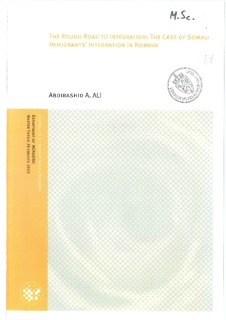| dc.description.abstract | Integration more than ever before, has become a major issue defining and shaping the contours of policies on social cohesion in most European countries including Norway. In Norway, Somalis are undeniably the most predominant and conspicuous African refugee group and have been identified as the most difficult group to integrate. In this thesis, the integration of Somalis in the Akershus region of Norway was explored. The aim of the study was to identify the challenges associated with the integration of Somalis in this region and to formulate recommendations for facilitating their integration. Even though the study
focused on the Akershus region, the findings made can contribute to the formulation of
better Norwegian policies on integration. The study identified several key challenges that inhibited the full integration of Somalis into mainstream Norwegian society. These
challenges included unemployment, inadequate housing, language barrier, discrimination and humiliation, cultural and religious differences, limited space in the political decision making processes, inadequate participation in community activities and limited institutional
support. On employment, it was found that about 27.03 % of the Somali group interviewed was engaged in menial jobs ranging mainly cleaning. A proportion had higher education from Somalia but was engaged in jobs completely different from their qualification. Language remained a major barrier for the integration of the Somalis, and was a vital ingredient for securing jobs. A major finding was the disparities in the cultural and religious
norms and beliefs of the Somalis on the one hand and their Norwegian hosts on the other
hand with respect to lifestyle. Some of the study participants also indicated they were
discriminated or humiliated at the workplace, schools and streets. Most of the study participants were either totally oblivious about the political process in Norway or had no interest in participating in the political space. Similarly, there appeared to be limited engagement of the study participants in community activities involving the host Norwegians. The study found that religious festivities marked the only prominent occasion where both Somalis communities and the host Norwegians inter-mingled. The study
recommends an effective introduction programmes for Somali refugees with strong education elements in the Norwegian language, skill development for job placement, among others. It is also recommended that Somalis already fully integrated into Norwegian society are involved in the introduction programme. This way, they can provide detailed
information about the Norwegian society from the Somali cultural perspective to assuage 7 any negative influences from other Somalis who may be against integration. Also, it is recommended that fully integrated Somalis be employed in the refugee camps, social welfare offices, and job search centres. It is further recommended that the case processing
time in the asylum camps is shortened so as to provide enough time for prospective Somali refugees to join the society. | en_US |
